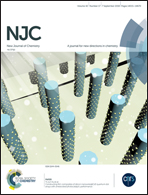A highly specific and sensitive ratiometric fluorescent probe for carbon monoxide and its bioimaging applications†
Abstract
The sensitive and accurate detection of intracellular gasotransmitter carbon monoxide (CO) is of great significance for unraveling its diverse cellular functions. Herein, we report a simple highly specific and sensitive 4-hydroxynaphthalimide-based ratiometric fluorescent probe Ratio-CO for monitoring CO levels in living cells. Probe Ratio-CO could quantitatively detect CO in the range of 0–50 μM by the ratiometric fluorescence spectroscopy method and the detection limit was measured to be about 17.9 nM. Additionally, probe Ratio-CO has been proven to possess preeminent selectivity towards CO over other bioactive species. Most importantly, the excellent response properties of probe Ratio-CO enable its applications in the monitoring of the fluctuations of CO levels in living cells by the ratiometric fluorescence imaging technique, and we thus anticipate that this probe would be a novel tool for further elucidating the biological functions of CO in living systems.



 Please wait while we load your content...
Please wait while we load your content...